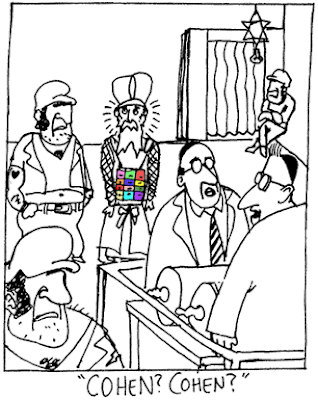Rabbi Kessin's latest shiur is now up on You Tube. The sound is not great but definitely better than the audio which was available a few days ago. In the lecture he mentions the Purim Codes in the Torah, which you can read about and watch in the Purim Codes video below.
[The following is adapted from Keeping Posted with NCSY, Fall 1999 edition and also from Torah.org article by Rabbi Dovid Rosenfeld]
There is a famous "code" in Megillat Esther :- towards the end of the story, King Ahashveirosh allows the Jews to avenge themselves of their enemies on the 13th day of Adar. In Shushan, the capital, the Jews kill 500 men and hang Haman's ten sons on a gallows. Queen Esther then approaches the King with an additional request: "...allow the Jews who are in Shushan to do tomorrow as they did today, and let the ten sons of Haman be hanged on the gallows" [Esther 9:13]. It's curious that she would request the hanging of Haman's already slain sons. Nevertheless, the King complies.
The Hebrew word for "tomorrow" ["machar"] occasionally refers to the distant future. Further, the Sages tell us that whenever the word "king" appears in the Megillah it alludes to the King of kings as well. Thus, the verse could be understood as a request by Esther to G-d to again hang the ten sons of Haman at some point in the distant future. Now, when the Megillah lists the ten sons of Haman during their hanging [Esther 9:7-9] there are a number of unusually-sized letters. [There is a tradition to write certain letters in the Torah larger or smaller than the standard size.]
According to the most accepted tradition, there is a large 'vav' [numerical value = 6] and a small 'tav' [400], 'shin' [300] and 'zayin' [7]. The following suggestion has been made: The large vav refers to the sixth millennium [of the Hebrew calendar]; the small letters refer to year 707 of that millennium. The meaning, then, is that G-d agreed to hang Haman's ten sons again in the year 5707 = 1946-7.
When listing the ten sons of Haman who were hanged [Esther 9:6-10], three letters, namely Taf, Shin, and Zayin, are written smaller than the rest [most printed texts reflect this; if yours doesn’t, look in another]. The commentaries offer no explanation for this other than that it is a prophecy. The letters "Taf-Shin-Zayin" represent the Hebrew year 5707, corresponding to the secular year 1946-47.
On October 16, 1946 (21 Tishrei, 5707) ten convicted Nazi war criminals were hanged in Nuremberg. (An eleventh, Hermann Goering, a transvestite, committed suicide in his cell. The Midrash tells us that Haman also had a daughter who committed suicide.) As if the parallel were not obvious enough without further corroboration, Nazi Julius Streicher’s last words were: "PURIM FEST 1946!". [In case you question the accuracy of Streicher’s last words, they are are well-documented; they appeared in Newsweek, October 28, 1946]
It is fairly safe to assume that (a) Streicher did not know about the three small letters in the Megilla, (b) he did not know that these letters corresponded to the year in which he was being hanged, and (c) even had he known, he would have had no motivation to reinforce the validity of Jewish texts, traditions, or prophecies. One could not ask for a more independent confirmation of the all encompassing knowledge to be found in the Sifrei Tanach.
It is fairly safe to assume that (a) Streicher did not know about the three small letters in the Megilla, (b) he did not know that these letters corresponded to the year in which he was being hanged, and (c) even had he known, he would have had no motivation to reinforce the validity of Jewish texts, traditions, or prophecies. One could not ask for a more independent confirmation of the all encompassing knowledge to be found in the Sifrei Tanach.
Rabbi Weissmandl - a great Hungararian scholar and holocaust survivor - made a number of findings concerning Megillat Esther using skip distances of 12,111 letters - the exact number of letters in Megillat Esther. If one starts with the first regular mem [as opposed to the "final mem"] in Bereishis 4:14, where the name Esther [vocalized differently] appears for the only time in the Torah, and count at intervals of 12,111 letters, one finds spelled out the phrase "Megillat Esther." Coincidence? I think not.












